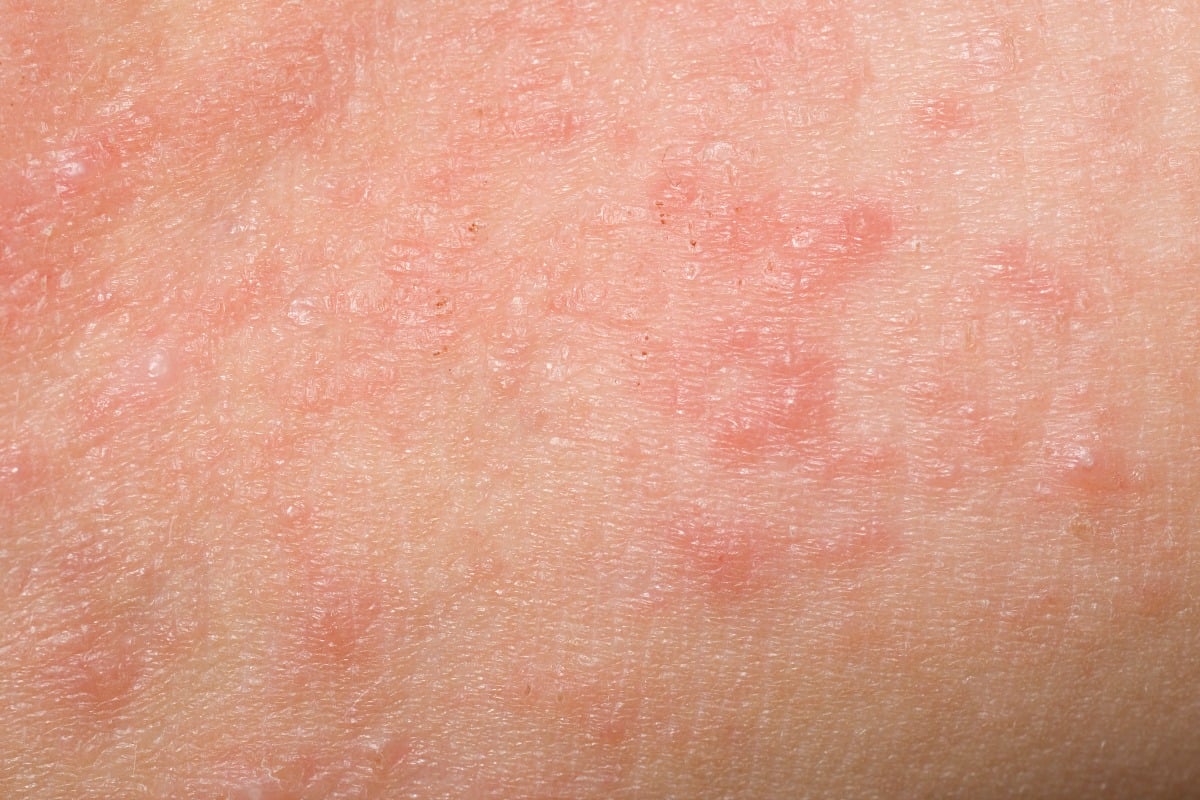
Just hearing the word “scabies” makes you feel itchy.
Scabies is a skin condition caused by Sarcoptes scabiei, a tiny mite that likes to munch its way into the superficial layers of your skin and wriggle around.
These itchy critters are so common that if you haven’t had scabies before, you’ll definitely know someone who has had it. We estimate that right now around the world, over 130 million people are scratching at their itchy, scabetic skin.
Scabies mites are so tiny that they can’t be seen with the naked eye. All you can see is the itchy, red rash they cause, so it’s easy to think you’ve just got an allergy and miss the proper diagnosis.
These mites usually spread via skin-to-skin contact, which is why we usually associate scabies infection with sexual encounters, but any close contact can transmit scabies.
Scabies mites move slowly, travelling up to 2cm each hour in the open air. They love being close to your body heat and stop moving if the temperature drops below 20 degrees Celsius.
Snuggling on a cosy couch, sharing a bed, trying on op-shop clothing, or being crammed onto public transport for more than 20 minutes can give the mites enough time to find the heat of your warm body. Even young doctors end up with scabies after working at the dermatology outpatient clinic. However, you’re unlikely to get scabies from a public toilet seat.
It can take more than six weeks before an itchy rash appears, so pinpointing the exact time and place you were first infected can be impossible.
Some people don’t notice much at all, but others develop an intensely itchy, red, lumpy rash. This occurs when your immune system goes into overdrive, reacting to microscopic mites munching their way through the surface of your skin.
Soft skin is easier to chew through, so scabies tend to bite the skin of your wrists, ankles, groin, flanks, around your belly button, above your breasts, and in the webbing between your fingers and toes. They don’t tend to bother your face or head.
A red bump marks the entrance to the mite’s burrow, and a curvy, pink line in your skin outlines the tunnel track.
Having sex only once makes the female mite pregnant for life. After this quick shag, she leaves her male companion and burrows into your skin at a slow speed of 1-5mm per day.
Your skin provides her with all the nutrition she needs and she poops a delicate trail of faecal pellets and lays 1-2 eggs every day as she continues to devour her way through your epidermis.
Most people with scabies only have about 10 or 20 mites crawling through their skin, but the itch can be felt all over the body.
Itchy rashes appear for all kinds of different reasons, so it’s important to see your GP and get a formal diagnosis. It can be tricky to identify and we sometimes need to perform a skin biopsy to look for signs of burrows, mites and eggs.
Some people have a dramatic scabies super-infection known as ‘Norwegian scabies’, ‘crusted scabies’, or ‘scabies hyper-infestation’.
It’s horrendous, but a person with ‘Norwegian scabies’ can have over one million mites living in their skin at one time.
If the infestation persists for many months or years without appropriate treatment, thick, crusted skin lesions appear all over the body. They are packed full of scabies mites, are highly infectious, and look awful. The only consolation is that when these crusts become super thick, they stop feeling itchy.
It’s no longer a big problem in Norway, but ’Norwegian scabies’ is currently a big problem on our home turf. Northern Australian families living in remote Aboriginal communities have the highest rates of scabies hyper-infestation in the world and this horrible condition is extremely difficult to treat.
Mild scabies infections can be fixed with a simple scabicidal cream (Permethrin 5%) sold over the counter in pharmacies.
This cream is best absorbed when your skin is damp so we usually recommend having a shower in the evening, pat your body dry with a towel, and rub the cream in. Cover every part of your skin from your neck down, including the webbing between your fingers and toes. You don’t need to put it on your face or scalp.
It dries quickly and doesn’t ruin your sheets, so leave the cream on while you’re asleep and have a shower in the morning to wash it off.
Put the clothes you’ve been wearing over the past three days into the washing machine and use the hottest water setting. Remember to wash your bedsheets as well. Hang everything up on a clothesline outside to dry, as direct sunlight helps to kill any remaining mites and eggs.
Scabicidal creams are good at killing off mites, but don’t always kill the eggs. You’ll need to repeat the treatment after seven days to kill the young mites just after they’ve hatched, but before they’ve had time to mate and lay more eggs.
Some people notice their itch calms down as soon as they’ve applied the cream, but it can take 2-4 weeks before the itch completely subsides.
If your skin keeps itching for more than a few weeks after treatment, then the initial diagnosis may have been wrong, you could have developed a ‘post-scabetic’ skin irritation, or you might have ‘super-scabies’ that just won’t die. Either way, you’ll need to see your GP or friendly Dermatologist for a check up.
It’s good to know that persistent infestations can be treated with oral tablets if topical treatments fail.
If your itchy, red bumps won’t go away and you’ve been scratching your skin till it bleeds – please see your doctor. You might have mites.
Brad McKay is an Australian doctor, television personality and author.
We have FIVE $100 gift vouchers up for grabs. Take our survey now for your chance to win.
Tags:


